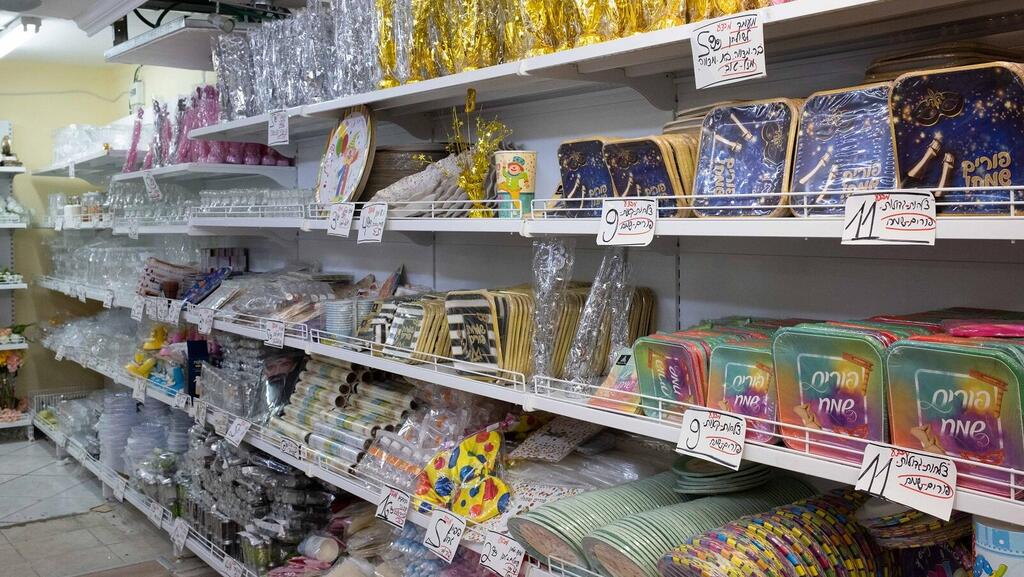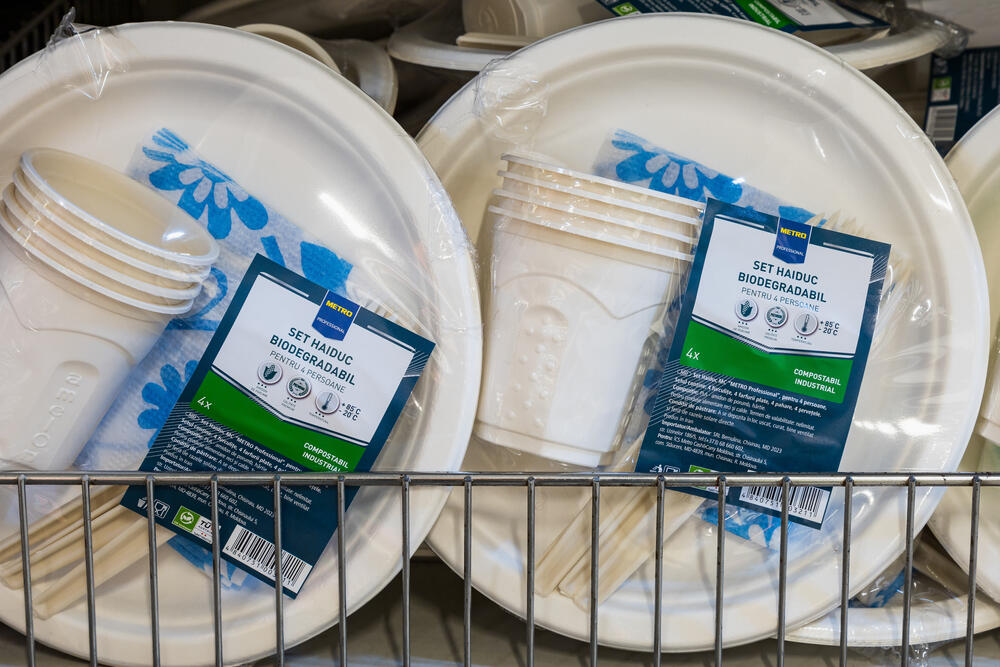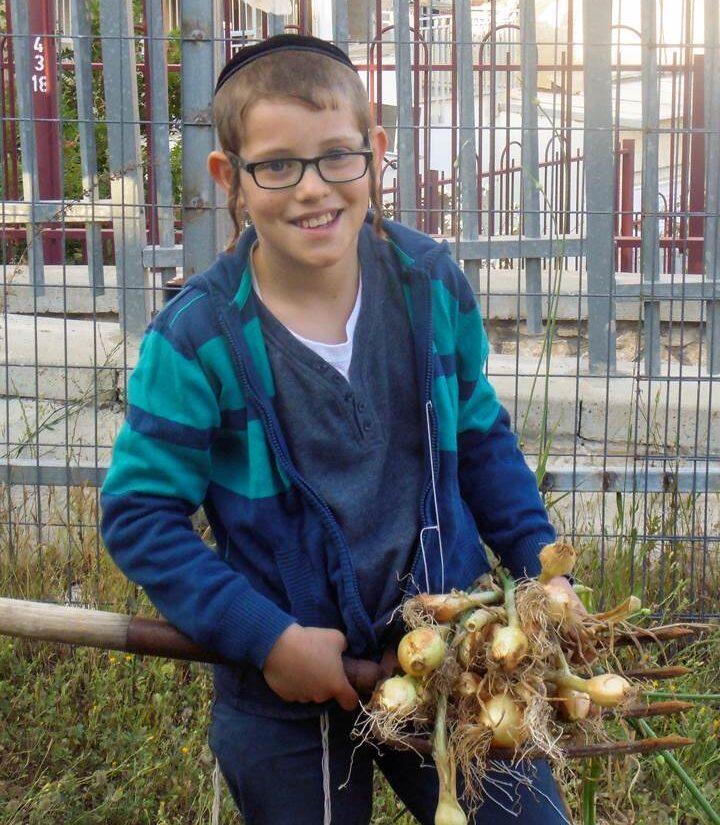Getting your Trinity Audio player ready...
As families around Israel gather for their evening meal, many ultra-Orthodox families will sit down to a table set with disposable plastic cups, plates and cutlery. The Haredi sector’s use of plastics recently came into the limelight when a government decision to double the tax on these disposables led to a vocal outcry.
Crying persecution, Haredi politicians and media outlets criticized the decision, claiming it targets the minority sector to little environmental advantage. The bill’s proponents, however, pointed to the fact that Israeli households use five times as much disposable plasticware as their European equivalents.
8 View gallery
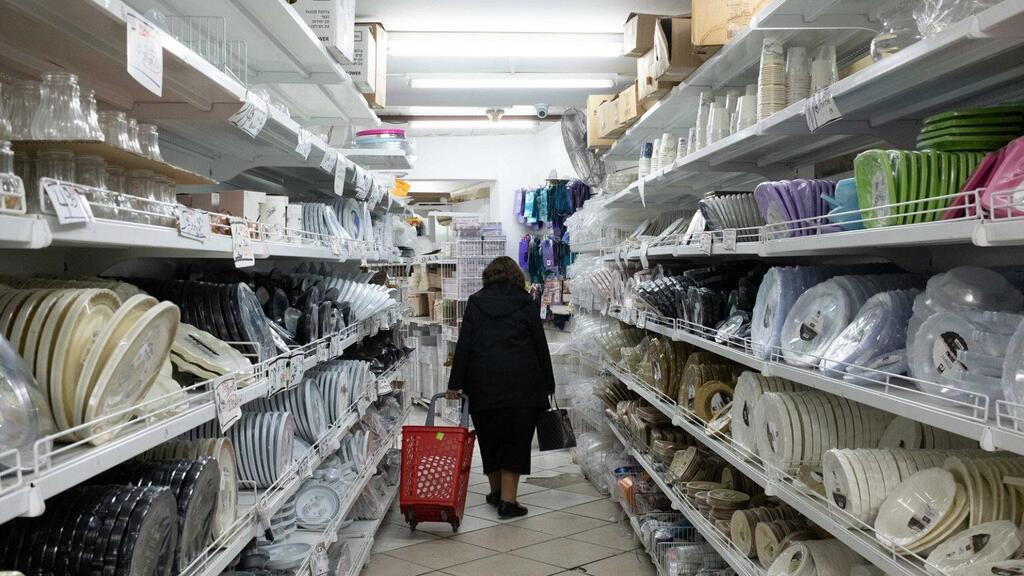

Disposables at a Haredi supermarket in Jerusalem, Jan. 17, 2022
(Photo: Daniel Sonnenfeld/The Media Line)
The ultra-Orthodox preference for single-use plastic can be attributed to the fact that the Haredi family is, on average, twice the size of a non-Haredi family. The larger size naturally increases the burden of cleaning after the meal. This pushes many ultra-Orthodox households to choose disposable plastic over more permanent, and less wasteful, ware.
The law took effect in the beginning of November, preceded by a furious rush to stock on plasticware. Now that two months have passed and prices have risen, a definite decrease in demand is felt, say storekeepers in the Haredi neighborhood of Geula, in Jerusalem.
Off the main road, an inconspicuous entrance below street level leads into a seemingly endless labyrinth of rooms, “The Bazaar of Dinner Table Artistry,” a store specializing in disposables. From napkins to decorated plastic dinnerware, everything needed to set a table can be found within the large shop, which Raphael, an employee, says is the largest in the area.
Since prices have risen, sales have decreased “by 40%, in my estimation,” he said. It is midday and the store is quiet, and Raphael relates that at this time of day before the hike in taxation, the shop’s many rooms would be bustling with customers.
Raphael expresses cautious support for the government decision, if it benefits the environment. In the past, he says, after the weekend, the neighborhood’s streets would be filled with garbage bags, packed with the dishware of Shabbat meals.
“The truth is that there was too much disregard” for the plastic dishes, because of their price, he says. At the same time, he isn’t sure about the government’s motives and the asserted environmental advantages.
Shmuel, who manages the adjacent Express Market, is clear cut in his opposition to the decision, which he calls “terrible.”
“It’s a dire blow” to the area’s families, he said. The supermarket has seen a decrease of 25-30% in sales, which now occur mainly ahead of the weekend. Shmuel notes that prices have tripled for some products, making them very expensive for large families.
The sudden attention given to the issue strengthened the notion – present in Israel as it is elsewhere – that environmental awareness is tied to a liberal and secular disposition. Contrarily, apathy toward climate change, according to the stereotype, is synonymous with traditionalism and religiosity. Indeed, what can express greater disregard for global warming than using a plastic cup to drink one glass of water, before adding it to the world’s waste piles? And yet, a closer look at the Haredi sector tells an entirely different story.
The surprising numbers: demonstrably green
There is no debate over the wastefulness and harmfulness of disposable plasticware. However, information gathered by the Israel Central Bureau of Statistics shows that despite the widespread use of plastics by the Haredi sector, the ultra-Orthodox create less waste than average, and significantly less waste than bastions of Israeli financial prosperity.
In 2019, every Israeli, on average, generated 1.8kg (almost four pounds) of waste daily. Residents of the affluent town of Kfar Shmaryahu in central Israel, however, produced almost 5.5kg of waste every day. In Tel Aviv, 2.6 kg of trash was created daily by the average resident.
In contrast, the residents of the large Haredi city of Bnei Brak produced a below-average 1.4kg a day. In the smaller ultra-Orthodox towns of Immanuel, El’ad and Beitar Illit, the average was around 1kg a day.
This trend continues when examining the number of cars per capita. Beitar Illit has less than one vehicle for every 10 residents; Bnei Brak about one car for every nine people living in the city. In El’ad, the rate is one car for seven residents.
In mostly secular communities, things are different. Tel Aviv, though, a car is shared by less than two people on average. In Herzliya, the rate is almost exactly two residents per vehicle, and in Ramat Gan, there were almost 100,000 cars in 2020, which served slightly fewer than 165,000 residents.
More generally, it appears that ultra-Orthodox households consume less. A 2021 report by the Israel Democracy Institute (IDI) shows that Haredi households spend 16% less than their non-Haredi counterparts on goods and services, and this despite being 70% larger on average. Further to this, members of the ultra-Orthodox sector travel abroad less.
Forty-six percent of non-Haredi Israeli Jews older than 20 vacationed abroad in 2019 and 2020, says the IDI report, while only 15% of adult Haredim chose to hop on a plane for some time away. Air travel is a notable contributor to a person’s impact on the environment.
The report also notes that the income of the average Haredi family is significantly lower than that of a non-Haredi Israeli family, which hints that a socioeconomic factor is driving the differences.
Esther Keynan, the Bnei Brak Municipality’s environmental education coordinator and a prominent voice for environmentalism in the Haredi sector, believes, however, that it’s a matter of values first and foremost.
8 View gallery
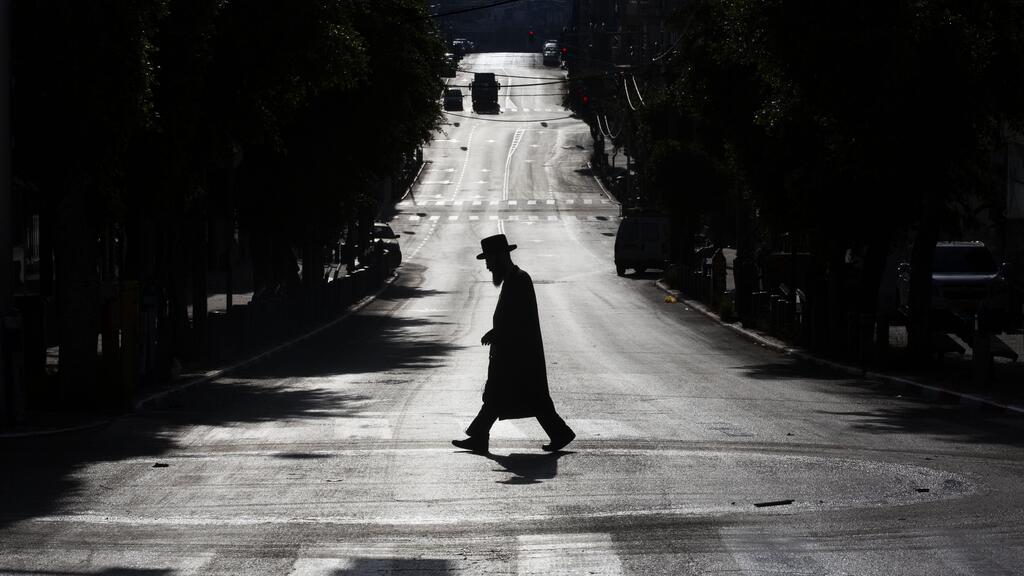

An ultra-Orthodox Jew crosses a mainly deserted street because of the government's measures to help stop the spread of the coronavirus, in Bnei Brak
(Photo: AP)
“There could be financial prosperity but still, being modest consumers is something that is deeply ingrained in the … [Haredi] lifestyle,” Keynan said. Buying less in the first place, and recycling clothing and other products, are all part of the Haredi lifestyle, which results, naturally, in less waste.
Keynan points also to observing Shabbat – wherein Orthodox Jews abstain from using machinery and electricity – as a point of alignment between Haredi, and Jewish, values, and limiting one’s impact on the environment.
Avishai Himelfarb heads Leshomra, likely the biggest Haredi environmental organization in Israel. Himelfarb doesn’t rule out that the lower Haredi income has an impact. Yet, he also stresses that Haredi values are of great importance.
The smaller footprint of Haredi families, Himelfarb said, “is not only for socioeconomic [reasons], but because of a different set of values. The Haredi public puts the Torah at the center, and that dictates, along with other things, green practicalities that are not for the sake of the environment, but because the Torah is at the heart of things.”
Rabbi Benayahu Tvila, an educator and superintendent of Haredi high schools at Israel’s Ministry of Education, places more stock in the socioeconomic element. He notes that in segments of the Haredi sector that enjoy greater financial prosperity, this is quickly translated into greater purchasing.
It’s important to note, Tvila said, that “when it comes to different lifestyles, the Haredi way of life is more ecological … than that of other communities.” This is the case not only because of economic factors, but also because of – once again – traditional Haredi values. Yet, the problem is that “this sector is evolving and changing. It is becoming less tradition, but not more [ecologically] aware,” he said.
And when it comes to ecological awareness, all three agree that – despite the surprising numbers mentioned above – the Haredi community may be lagging behind.
Lost in translation: green norms without green awareness
“There is a little bit of awareness” of the issues of climate change, Tvila said. “The awakening is happening now, in my opinion. For many years, there wasn’t much talk about the subject, only as an issue belonging to the seculars, the liberals, [seen] as a waste of time or a hobby. The urgency wasn’t understood at all.”
8 View gallery
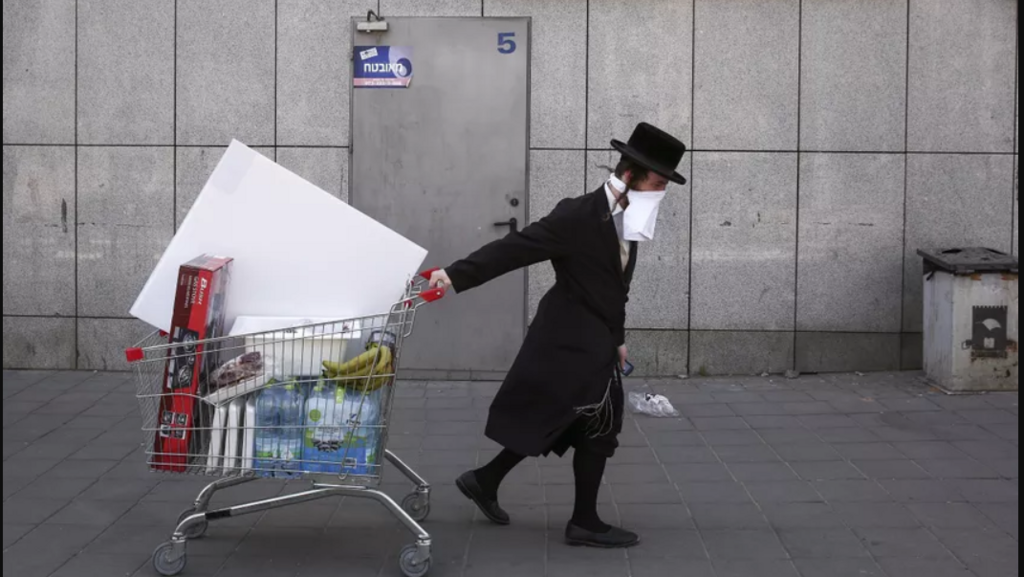

An ultra-Orthodox Jew wears an improvised protective face mask as he pulls a supermarket cart in Bnei Brak
(Photo: AP)
There are several reasons for this lack of interest, which leads to a lack of awareness. Understanding climate change “demands a basic level of scientific knowledge,” Tvila says. “But in our sector, sadly, the education system doesn’t give the sciences enough attention.
“There are also deeper claims.” Tvila says that when discussing the matter within the Haredi world, he has encountered a theological stance “that it isn’t our concern, that God takes care of the world.”
Keynan sees things differently, and explains that “ecological concepts and actions are built into the Haredi or Orthodox lifestyle. It is just the professional, scientific language that is unknown to them. Green ideas such as being mindful of what you buy and limiting yourself are translated in Haredi language to the Jewish value of self-restraint and moderation.
“The issue is mainly one of terms,” she continues, “and when they are translated, when we adjust them to key concepts known to the Haredi public, their cooperation is incredible, no less than any other community.”
This does not mean that all environmental terms have corresponding Jewish concepts, and some in fact contradict each other, she notes. Furthermore, matters on a global scale – global devastation, global change and global activism – find little traction in the Haredi world. Isolating the environmental issue – and the relevant Jewish commandments – does not necessarily align with the Haredi worldview.
“There is no hierarchy to the importance of Jewish commandments. Observing Jewish law relates to it all, and the climate revolution, or designating the environmental issue a separate topic – that doesn’t work for them,” Keynan says.
Himelfarb, in turn, points to a specific aspect of ultra-Orthodox life as a central barrier to awareness.
“The Haredi public lives distanced from nature. This is true for all urban populations, but especially for the Haredi sector, because it lives in very densely populated areas, a large percentage of the public doesn’t have a private vehicle, and a significant number doesn’t have access to information sources – such as the internet – that assists in reaching different kinds of natural sites.”
To this he adds that in Israel, traditionally, connecting with nature was tied with a Zionist worldview, an appreciation for the Land of Israel. “The Haredi public, at least in the past, saw Zionism as a threat,” said Himelfarb, and this widened the chasm between the sector and the surrounding natural habitat.
It is this chasm, between the Haredi public and its values on the one hand, and on the other, the world of nature and environmental awareness, that both Himelfarb and Keynan are striving to bridge in their work.
Connecting and reconnecting: traditional values and the environment
The Haredi sector “is a very activist community, when [the cause] is understood,” Keynan says. And, as an environmental education coordinator, her job is to create the environmental curriculum taught at Haredi kindergartens and schools that creates better understanding.
“I write the curriculums used in schools, seminars and kindergartens, which bring the environmental world into their lives. In kindergarten, that means growing fruits and vegetables in the garden, so that the children will see with their own eyes that tomatoes don’t grow in the supermarket and cucumbers aren’t manufactured in factories,” she said. Naturally, older children delve more deeply into the environmental world and learn about such topics as water and air pollution.
Keynan says that her efforts are met with much interest and goodwill. Giving “one small example,” she relates that growing up in Bnei Brak, her greatest nightmare was Lag BaOmer, a Jewish holiday that involves lighting bonfires. A 2021 report by BDO, a global accounting and consulting firm, stated that the air pollution created by Lag BaOmer’s night of fiery celebration is equal to the pollution generated by 70,000 cars over an entire year.
Bnei Brak “is such a densely populated place, and children gather firewood and set it alight,” Keynan says. Even worse, plastics and old furniture are also thrown into the flames. This is done “because of the community’s ignorance,” she adds, so “for five years, we ran a campaign that linked air pollution with the bonfires, and the number of fires in Bnei Brak came down by 85%.”
Nowadays, Keynan’s projects are not limited to Bnei Brak, and Haredi municipalities from around the country make use of her expertise and material to change the status quo and create awareness.
Keynan stresses that beyond the connection between Haredi values and ecological terms, there is a deeper, conceptual foundation for a green attitude that can be found in the Jewish tradition.
“Take for example bal tashchit,” she said, pointing to the Jewish ethical principle, drawn from Deuteronomy 20:19–20, which commands, “Do not destroy.” The concept first appears in the Bible as the Israelites are about to enter the Land of Israel, and Moses commands that they not harm tree-bearing fruits in their battles with the Canaanites.
“What’s the big deal? The command could be to plant another tree [instead of to preserve the existing trees]. … But no, there is an understanding that our treatment of the world around us … needs to be on a different level, that it exists independent of us."
Himelfarb also sees a deep connection between Jewish tradition and an environmental agenda. “My work in its entirety is to show how [treatment of] the environment is part of the sphere of Musar,” he says, referring to the branch within the Jewish tradition that deals with ethical conduct. The realm of Musar “is very developed within the Haredi world … and my claim is that [environmental consciousness] is a part of that. … I am trying to create authentic Haredi environmental terminology,” he said.
Leshomra runs activities aimed at connecting children with nature while instilling ecological awareness. It also trains teachers and guides.
“We do two things,” Himelfarb said. “We create more opportunities for the Haredi public to interact with nature physically, and always combine this with an active and fun meeting with nature, which could be of an agricultural nature, or hiking…, environmental values as we see them.”
8 View gallery
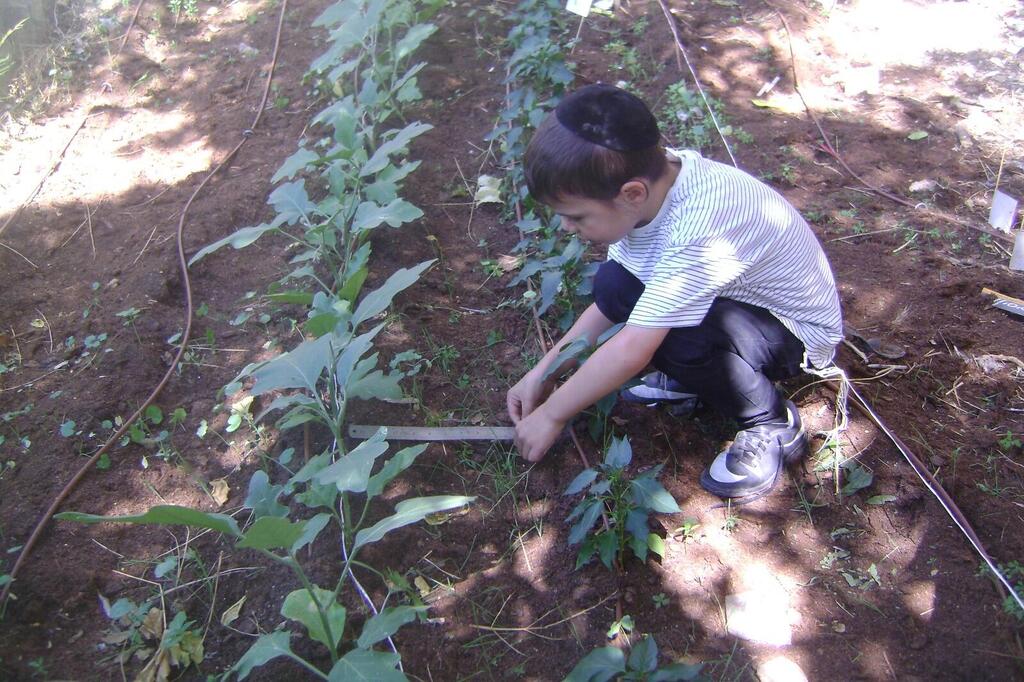

Experiential nature of Leshomra’s activities is the key to their success
(Photo: Courtesy Leshomra)
The experiential nature of Leshomra’s activities is the key to its success, Himelfarb says. “Even on an existential level, a child living in a dense urban area needs a connection with nature. This is not always on offer.”
Leshomra was founded seven years ago, and Himelfarb says that before the pandemic, the size of its operations doubled every year. In 2019, the organization ran 300 weekly activities for children throughout the country. Additionally, 200 educators that it trained also operate in Israel.
Not all environmental agendas align with the Haredi viewpoint, and Himelfarb emphasizes that Torah and Halacha, Jewish religious law, take precedence over ecological concerns. Yet, in many ways, he says, “there is no divide between the values of the Torah and environmental values.”
The article was written by Daniel Sonnenfeld and reprinted with permission from the Media Line


